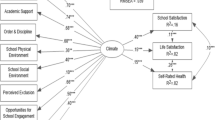Abstract
The major goal of this study was to investigate relationships among levels of 341 secondary school students’ school satisfaction and various intrapersonal, interpersonal, and academic measures. The measures included the School subscale from the Multidimensional Students’ Life Satisfaction Scale (Huebner, 1994), Students’ Life Satisfaction Scale (Huebner, 1991), Children’s Hope Scale (Snyder et al. 1997), Behavioral Assessment System for Children (Reynolds & Kamphaus, 1992), self-perceived grade point average (GPA) and participation in extracurricular activities (SEAs). Students were placed into three groups based on their school satisfaction reports, including very low (lowest 20%), average (middle 30%), and very high (highest 20%) levels of school satisfaction. Students with very low school satisfaction differed from students with very high school satisfaction on all adjustment measures; students with very low school satisfaction also differed from students with average levels of school satisfaction on all measures, except the self-esteem measure. Relative to students reporting average levels of school satisfaction, students reporting very high satisfaction demonstrated significantly higher scores on measures of global life satisfaction, hope, internal locus of control, and GPA. Finally, only three students in the very high satisfaction group and nine students in the average satisfaction group reported clinical levels of psychological symptoms. In the very low satisfaction group, clinical levels of symptoms were reported by 30%, 22%, and 16% of the students on the Clinical Maladjustment, Personal Adjustment, and Emotional Symptoms Index, respectively. Implications for future research and educational practices are discussed.
Similar content being viewed by others
References
Accordino DB, Accordino MP, Slaney RB (2000) An investigation of perfectionism, mental health, and achievement motivation in adolescents. Psychol School 37:535–545
Andrews FM, Withey SB (1976) Social indicators of well-being: American's perceptions of life quality. Plenum, New York
Baker JA, Terry T, Bridger R, Windsor A (1997) Schools as caring communities: a relational approach to school reform. School Psych Rev 26:586–602
Baker JA, Dilly LJ, Aupperlee JL, Patil SA (2003) The development of school satisfaction: schools as psychologically healthy environments. Sch Psychol Q 18:206–221
Cock D, Halvari H (1999) Relations among achievement motives, autonomy, performance in mathematics, and satisfaction of pupils in elementary school. Psychol Rep 84:983–997
Csikzentmihalyi M, Schneider B (2000) Becoming adult: How teenagers prepare for the world of work. Basic, New York
Epstein JL (1981) Patterns of classroom participation, student attitudes, and achievements. In: JL Epstein (ed) Quality of school life. Heath, Lexington, Massachusetts, pp. 81–116
Epstein JL, McPartland JM (1976) The concept and measurement of the quality of school life. Am Educ Res J 13:15–30
Frederickson BL (2001) The role of positive emotions in positive psychology: the broaden-and-build theory of positive emotions. Am Psychol 56:218–226
Gilman R (2001) The relationship between life satisfaction, social interest, and frequency of extracurricular activities among adolescent students. J Youth Adolesc 30:749–767
Gilman R, Huebner ES (2000) Review of life satisfaction measures for adolescents. Behav Change 17:178–195
Gilman R, Huebner ES (2003) A review of life satisfaction research with children and adolescents. School Psych Rev 18:192–205
Gilman R, Meyers J, Perez L (2004) Structured extracurricular activities among adolescents: Findings and implications for school psychologists. Psychol Sch 41:31–42
Hegarty S (1994) Quality of life at school. In: D Goode (ed) Quality of life for persons with disabilities: International perspectives and issues. Brookline Books, Cambridge, Massachusetts, pp. 241–249
Huebner ES (1991) Initial development of the students' life satisfaction scale. Sch Psychol Int 6:103–111
Huebner ES (1994) Preliminary development and validation of a multidimensional life satisfaction scale for children. Psychol Assess 6:149–158
Huebner ES, Drane W, Valois RF (2000) Levels and demographic correlates of adolescent life satisfaction reports. Sch Psychol Int 21:281–292
Huebner ES, Laughlin JE, Ash C, Gilman R (1998) Further validation of the multidimensional students' life satisfaction scale. J Psychoeduc Assess 16:118–134
Huebner ES, Suldo SM, Smith LC, McKnight C (2004) Life satisfaction in children and youth: empirical foundations and implications for school psychologists. Psychol Sch 41:81–93
Huebner ES, Valois RF, Paxton R, Drane W (2005) Middle school students' perceptions of quality of life. Journal of Happiness Studies 6:15–24
Larson RW (2000) Toward a psychology of positive youth development. Am Psychol 55:170–183
Mahoney JL (2000) School extracurricular activity participation as a moderator in the development of antisocial patterns. Child Dev 71:502–516
Reynolds CR, Kamphaus RW (1992) Manual for the behavioral assessment system for children. American Guidance Service, Circle Pines, Minnesota
Snyder CR, Hoza B, Pelham WE, Rapoff M, Ware L, Danovsky M, Highberger L, Rubinstein H, Stahl KJ (1997) The development and validation of the children's hope scale. J Pediatr Psychol 22:399–421
Snyder CR, Lopez SJ, Shorey HS, Rand KL, Feldman DB (2003) Hope theory, measurements, and applications to school psychology. Sch Psychol Q 18:122–133
Verkuyten M, Thijs J (2002) School satisfaction of elementary school children: The role of performance, peer relations, ethnicity, and gender. Soc Indic Res 59:203–228
Author information
Authors and Affiliations
Corresponding author
Rights and permissions
About this article
Cite this article
Huebner, E.S., Gilman, R. Students Who Like and Dislike School. Applied Research Quality Life 1, 139–150 (2006). https://doi.org/10.1007/s11482-006-9001-3
Received:
Accepted:
Published:
Issue Date:
DOI: https://doi.org/10.1007/s11482-006-9001-3




